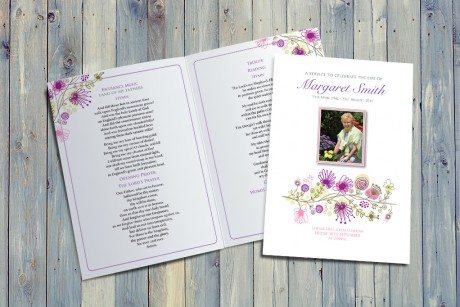When a loved one, friend or relative passes, it can feel unusual having to plan the funeral events. It is a task that everyone will dread, but also, it is an important task that contributes to the memory and send-off of the deceased. Funeral order of service is usually the most popular form of funeral stationery and can be kept for years to come.
An order of service can be used for several formal events, such as weddings and christenings. However, for a funeral, the order of service can serve an integral role both during the service and afterwards. Traditionally, the funeral order of service is used to categorise the events of the day. It typically will include all the relevant information about the service, including any hymns, poems or songs included in the service. These usually will be written down for guests to follow along with.
Additionally, the funeral order of service will include further information, such as location, time, and place of awake, as well as any other information. Such as:
· Charity donations
· After events
· Deceased’s last wishes
· Family last wishes
When writing a funeral order of service, it may be worth checking the will of the deceased to see if they had any particular wishes for their funeral, such as songs or hymns or other readings. Additionally, there may have been other relevant information such as where they wanted the funeral to be held or who they wanted to conduct the service.
The funeral order of service will detail all this relevant information so that guests understand the timeline for the day.
The front page
The front of the order of service should include the name of the deceased, as well as their birth and death date, and a picture. The front-page picture typically is a picture of the deceased alone.
Inner pages
The inner pages can vary depending on ho9w much information you would like to include. Usually, it will look something like the below.
· Entrance Music
· Introduction and Welcome by the Celebrant
· Hymn, Prayer or Verse
· Reading
· A Funeral Address or Appreciation of the life
· Eulogy
· Hymn, Prayer or Verse
· Commendation & Farewell
· Committal
· Dismissal and Blessing
· Exit Music
However, it can also include other information about the deceased’s work, passions, achievements, etc. Other pictures can be included in the inner pages if you wish, such as pictures with family and at important times in their life.
Back page
The back page is not necessary but usually will include a picture of the deceased, perhaps a word of thanks from the family, and any other information such as donations to charities or organisations. An example is below.
“The family would like to thank everyone for attending the funeral service today.
Donations in memory of [name] are welcome and encouraged for [charity name] that was so dear to [name]’s heart.
Light refreshments and drinks will be held at [location, time] following the service. You are all warmly invited to honour [name] and share cherished memories.”
Keepsake
For some guests, the funeral order of service functions not only as a guide to the day’s events but also as a valuable memento. Having a long order of service can be a sentimental touch for funeral guests. A longer booklet that details the life and achievements of the deceased can serve as a valuable keepsake for the guests. If you are considering a longer order of service, some ideas of what to include are below:
· Pictures of the deceased’s achievements
· Favourite quotes/poems/sayings of the deceased
· Details of their interests, such as donations to a club or charity they cared about
· Their last wishes (if they wanted them shared)
· Pictures with family/friends.










